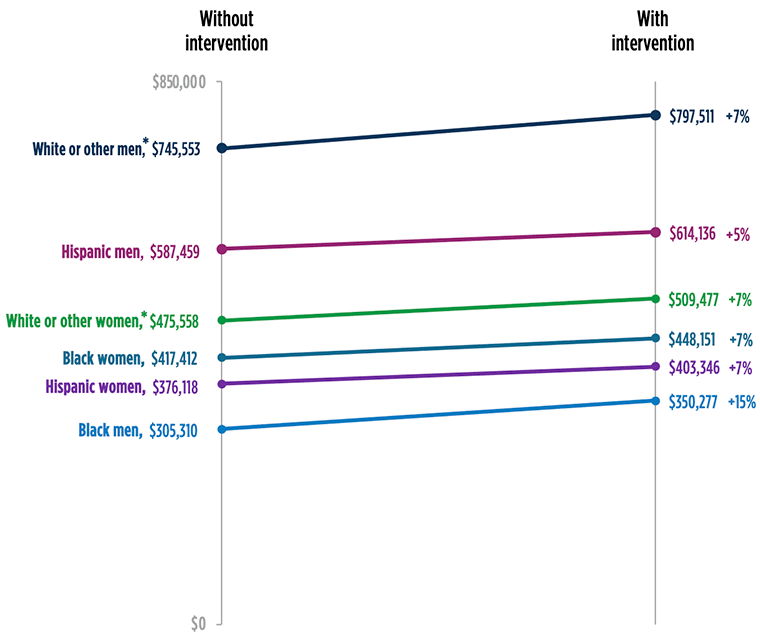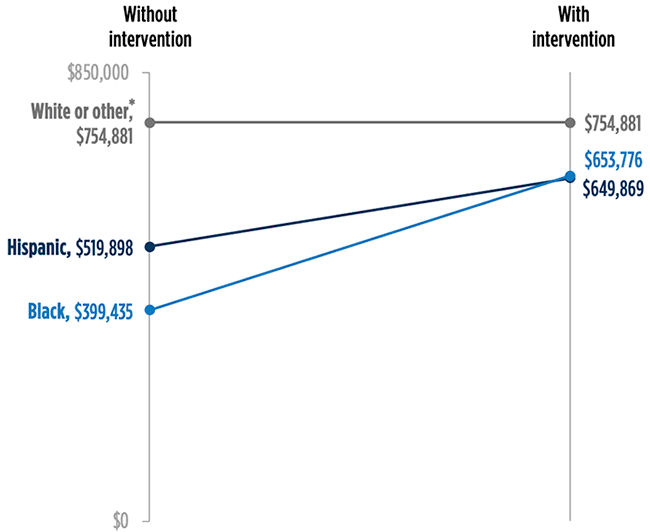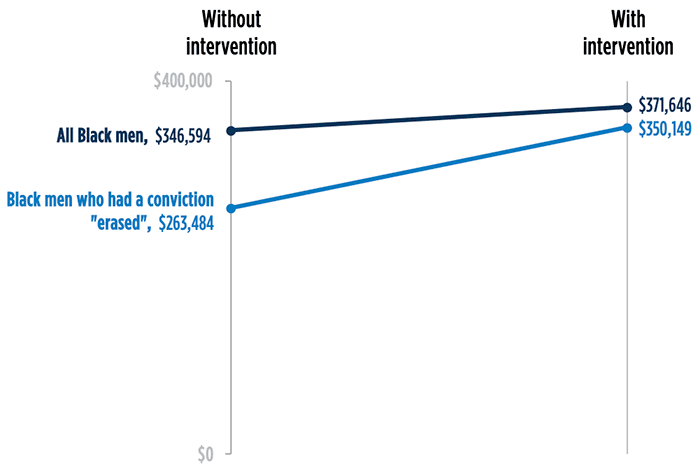Simulation Models Can Forecast Long-term Outcomes for Youth at “Crossroads Moments”
Many interventions that are designed to support or improve outcomes among children and youth have been evaluated, but few evaluations assess the long-term effects of interventions. A new report (and accompanying digital feature) from Child Trends and the Urban Institute presents findings from simulations of interventions aimed at improving key “crossroads moments”—or critical moments that can set adolescents and young adults on an upward or downward path of economic mobility. These simulations use the Social Genome Model (SGM), an analytic tool that can project the effects of approaches that support the development of children and youth. (See more about the SGM at the end of this blog.)
Using the SGM, Child Trends and the Urban Institute projected the outcomes of interventions to age 30, and earnings throughout the work lives of these interventions’ target populations. These simulations help assess approaches to addressing some of the United States’ fault lines around socioeconomic status, education, and race—many of which have likely been exacerbated by two years of COVID-related disruptions.
We simulated outcomes for several of these crossroads moments:
1. Students who attend schools that provide broad supports to students and their families have stronger outcomes in a range of areas.
The COVID-19 pandemic has emphasized that children’s academic achievement is influenced by their health and their social and emotional well-being—not just by teaching. Many schools have responded to the link between academic achievement and well-being by providing integrated student supports, such as social-emotional learning programs and other supports for students and families. We used the SGM to simulate what would happen if students in families with low incomes attended high schools that provide broad supports to students and their families. These simulated changes led to better mental health, higher GPAs at the end of high school, reduced delinquency, fewer criminal convictions, more education, and notable reductions in poverty in young adulthood.
Attending schools that provide broad supports increased lifetime earnings projections for all demographic groups in our simulation
Simulated increase and percentage increase in lifetime earnings, by race/ethnicity and sex

* Note: The White and other race group includes a small percentage of people who identify as Native American, Asian or Pacific Islander, or more than one race; because of sample size constraints, the SGM cannot estimate simulations separately for this group.
2. Removing or reducing discrimination based on race and ethnicity would increase educational attainment and lifetime earnings for Black and Hispanic youth.
The pandemic has also drawn renewed attention to the challenges that people of color face regarding work, health care, and income. Reflecting this, the research team conducted another SGM simulation to estimate the cost of structural racism by statistically removing barriers faced by Black and Hispanic youth. The team found that these youth were more likely to obtain an Associate of Arts or a Bachelor of Arts degree under these conditions; the simulation also resulted in greater equity in earnings across racial and ethnic groups. For example, Black men’s lifetime earnings were estimated to increase from 39 cents for every dollar in lifetime earnings by White men to 91 cents per dollar.
Addressing racial or ethnic discrimination increased lifetime earnings projections for Black and Hispanic people in our simulation
Simulated increase in lifetime earnings, by race/ethnicity

* Notes:
1. There are no changes depicted for White or other race people because the simulation was to eliminate structural racism for Hispanic and Black people.
2. The White and other race group includes a small percentage of people who identify as Native American, Asian or Pacific Islander, or more than one race; because of sample size constraints, the SGM cannot estimate simulations separately for this group.
3. Black men have better lifetime outcomes in mental health, educational attainment, and earnings when they are not subject to aggressive policing.
Researchers have identified that aggressive policing practices have negative consequences for young people. We simulated removing these negative effects by increasing attendance at school, raising math and reading test scores, improving mental health, and reducing criminal conviction rates among young Black men. Overall, these changes improved Black men’s mental health later in life, slightly increased their college graduation and employment rates, and improved their lifetime earnings by about $25,000. Black men who had a conviction erased in the simulation gained about $86,000 in lifetime earnings.
Reducing aggressive policing increased lifetime earnings projections for Black men, especially for those who had a conviction erased in the simulation
Simulated increase in lifetime earnings for all Black men, and for Black men with convictions erased in the simulation

In addition to these three simulations, the report’s five other simulations assess the benefits of improving the quality of low-wage jobs for young adults; increasing the attainment of high school diplomas, associate degrees, and bachelor’s degrees; and providing additional training to workers.
While the SGM simulations assess the benefits of various interventions to individual young people, they cannot calculate the broader improvements conveyed to society of having a better-educated population with higher incomes and greater equity. The simulations also cannot capture the ways in which improved outcomes might benefit young people’s families, their communities, and the next generation of children. The SGM simulations do not point to silver bullet solutions for challenges that young people face, but they do provide us a sense of how various interventions might benefit youth. They also identify strategies and interventions that policymakers and the public may view as worthy of further investment.
Learn more about the Social Genome Model, a partnership between Child Trends, the Brookings Institution, and the Urban Institute.
© Copyright 2024 ChildTrendsPrivacy Statement
Newsletter SignupLinkedInThreadsYouTube